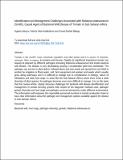| dc.description.abstract | Tomato is the world's most consumed vegetable crop after potato and it is source of vitamins, minerals, fiber, lycopene, β-carotene and income. Despite its significant importance tomato can heavily be attacked by different pathogens including Ralstonia solanacearum that incites bacteria wilt disease. The disease is very devastating causing a considerable yield loss worldwide. The pathogen can survive in plant debris, infected plants and host weeds and spread from one field to another by irrigation or flood water, soil, farm equipment and workers and weeds which usually grow along waterways and it is difficult to manage due to complication in biology, nature of infestation and wide host range. In areas like the Sub-Saharan Africa where there exists a wide diversity of plant species, the pathogen becomes even more difficult to manage. It is on this basis that this review article, clearly discusses challenges for bacterial wilt disease identification and management in tomato farming systems with respect to the diagnosis methods used, pathogen genetic diversity and host range and pathogen survival mechanisms under different environment. The information will empower the responsible personnel involved in tomato production chain to have clear information about the pathogen and management options available against the disease in Sub-Saharan Africa. | en_US |

